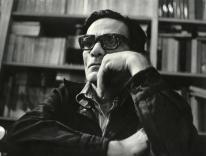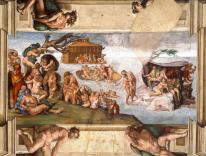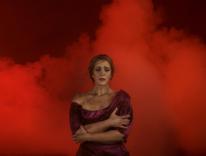Emil Antonucci, the gifted artist and graphic designer who created Commonweal’s distinctive new format in 1965 (he dropped The from the logo and invented the magazine’s colophon), and who remained involved in its design and production until 1998, died in Brooklyn on Memorial Day weekend, following a stroke. He was seventy-six.
A graduate of Cooper Union in New York City, Emil, as he was affectionately known by colleagues, clients, and his students at Parsons School of Design (where he taught for more than forty years), was the recipient of both Guggenheim and Fulbright fellowships. As a high school student, he was introduced to the work of British Catholic artist and pacifist Eric Gill. While at Cooper Union, Emil began contributing drawings to the Catholic Worker, and Dorothy Day asked the young student to address the group on the role of the artist. Soon Emil was contributing cover art and article illustrations to the brilliant, meteoric journal, Jubilee, edited by Thomas Merton’s writer friends Ed Rice and Robert Lax. He also created a larger-than-life mural of the Magi for the magazine’s offices, the basis for a later Jubilee cover.
Emil became Lax’s life-long collaborator (the latter died in 2000), creating books and pamphlets that showcased Lax’s minimalist poetry. “Lax, with his usual grave modesty,” Emil recounted in Commonweal in 1996, “let me see his poetry. I had just spent my meager savings on a hand-printing press and some fonts of Gill’s Perpetua. I offered to print some small chap books of his poetry. He actually trusted me to design and illustrate his work with total freedom and confidence in my artistic judgment. Heady stuff.” Using money from a Guggenheim grant, Emil launched the Journeyman Press. Over the next quarter-century he produced a series of publications that combined Lax’s experimental poems with his own playful line drawings. Lax later dedicated A Thing That Is (Overlook Press, 1997) to Emil, “whose Journeyman Press began it all.”
Lax introduced Emil to an agent who, in turn, brought him to the attention of Philip Johnson, the architect. At the time, Johnson was designing the Four Seasons restaurant in Manhattan. On the occasion of its fortieth anniversary, Mimi Sheraton of Vanity Fair described the restaurant as “a monument to timeless elegance.” She noted that Emil created the Four Seasons’ distinctive emblem-featuring four stylized trees that came to symbolize the restaurant’s elan-and that Emil’s color scheme for the trees carried over to the uniforms of the staff, to “a tile in the center of the restaurant’s original black service plate...and to the matchbook and menu covers.” Emil worked with Johnson on other projects, including for the 1964 World’s Fair and for New York University. At the time he was also designing book covers, first for Harper Brothers, then for Sheed & Ward, and later for Paulist Press; teaching at Parsons; creating reports for prominent foundations; and maintaining an independent artistic course, all the while living on a shoestring.
Emil devised the new Commonweal look in 1965, including the magazine’s symbol: a globe that interweaves church and world in the generous spirit of Vatican II. He redesigned the magazine in 1978 and 1987, and contributed new illustrations and covers for another decade. His Commonweal “brand” extended to stationery, ads, promotional materials, and conveyed not only Emil’s intelligence but his wit (his illustration honoring Senior Editor Robert Hoyt’s seventy-fifth birthday sported Hoyt’s face merrily emanating from the Sphinx). In 1983, Emil also created visual identities for the newly founded National Pastoral Life Center, its publications and magazine, Church (where he worked until the time of his death), and later for the Common Ground Initiative and for the New York City Charter Commission. His February 28, 1992, cover for Commonweal won first place in the Catholic Press Association’s annual competition.
Emil’s illustrations for Commonweal range from bold, woodcut-style block prints, to faces created entirely from simple dots, to linear, reverse images reminiscent of etchings. He loved to intersect faces and to improvise on patterns and symbols. On several occasions he described his philosophy and vision in the magazine. “I see art as the creation of structures, the creation of worlds that meaning may inhabit, but not define,” he mused. Great works of art provide the structures “that can be inhabited by successive generations. I see the way art works as an analogy of God’s presence in the world.” In keeping with this incarnational insight, Emil observed that “art breaks down the cultural fences that separate us and helps to invent a culture that brings us together.” He suggested that “the seductive appeal of Catholicism, for me, is that it asserts the continuity of the physical and spiritual worlds.”
In one of Robert Lax’s later poems, “Byzantine Faces,” Lax described what spoke to him in those gilt iconic representations: It was their “spark of living.” That same spark was immediately apparent when you encountered Emil Antonucci. Although he was an entirely unassuming and gentle man (he usually dressed in a dark shirt and workman’s pants), his eyes would shine with recognition and his speech would resonate welcome. His artistic work reveals those same generous aspects, and will ensure his legacy. His spirit, on the other hand, will remain to beckon us upward.
Please email comments to [email protected] and join the conversation on our Facebook page.
Share
Previous Story
Body Beautiful
Next Story
Northern Exposure


